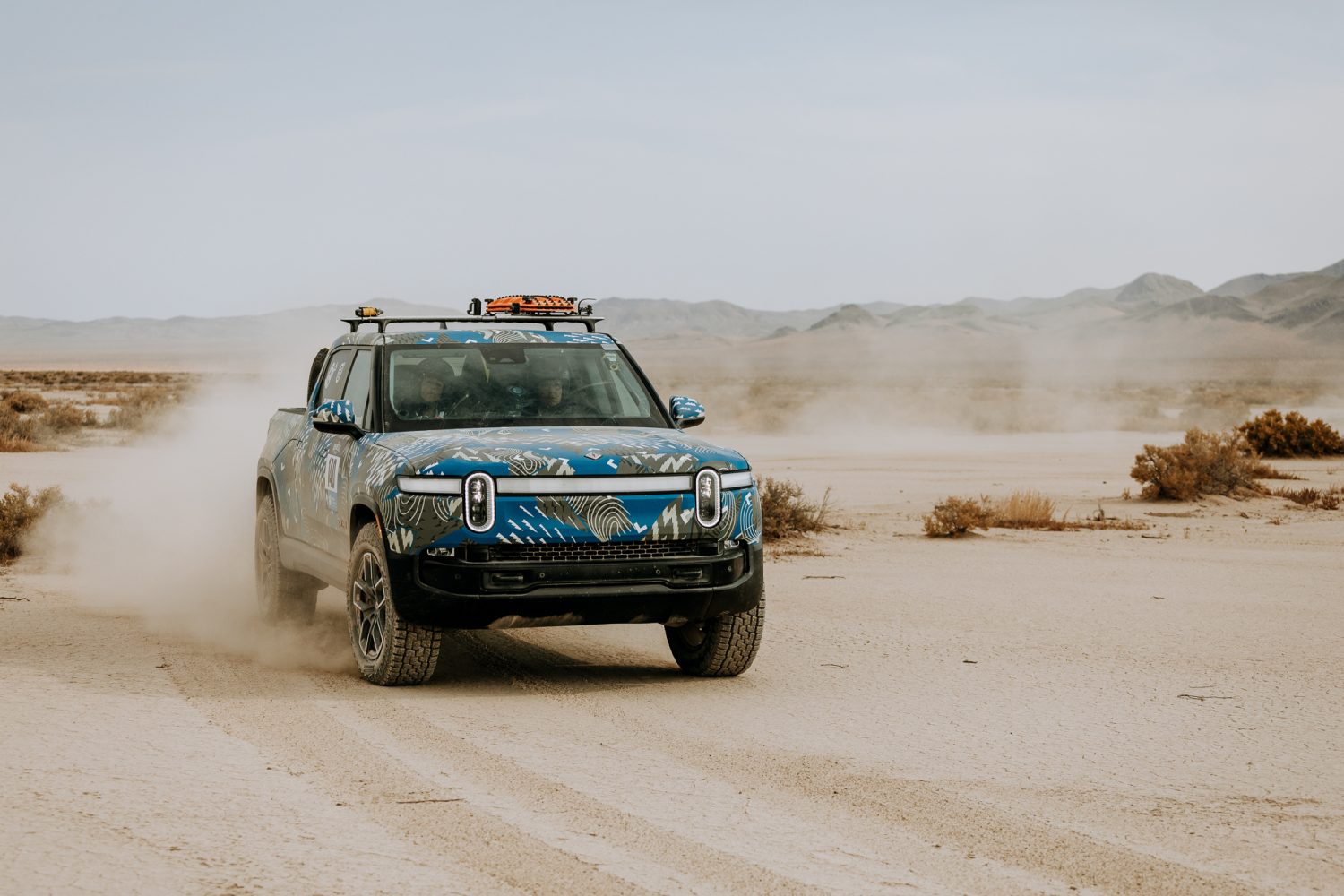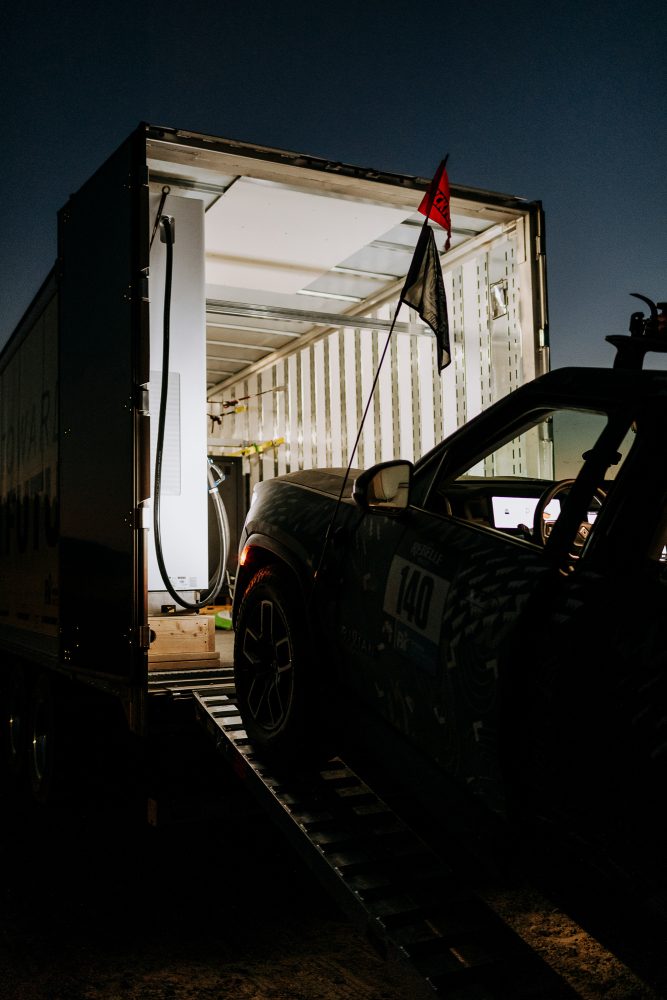Editor’s note: This article was originally published in Overland Journal’s Summer 2021 Issue.
Photography by Richard Giordano
The electric vehicle revolution is here. From Long Way Up to the Extreme E Challenge, electric vehicles are gaining popularity and exhibiting great potential. With countless automotive manufacturers announcing plans to build all-electric pickup trucks, such as Tesla’s Cybertruck, the GMC Hummer EV SUT, and Ford’s F-150 Electric, it’s an exciting time, ripe with innovation and possibilities. But one potential hang-up for the long-term overlander—and it is an important one—is the issue of range.
As overlanders, we pride ourselves on getting off the beaten track. We install long-range fuel tanks, strap extra gas cans to our vehicles, and calculate how far we can stretch those last liters of water or tins of food, all to explore hard-to-reach places along dirt roads or through difficult terrain. So how far away are we from using electric vehicles for long-term overlanding? What is the range really like in off-road conditions? Fortunately, a real-life proving ground for EVs exists in our own backyard—the Rebelle Rally.

Primarily taking place in the dusty, rock-strewn OHV areas of Nevada and California, the Rebelle Rally is an eight-day off-road navigation rally solely for women. Emphasizing precise navigation over speed, competitors use maps, compasses, and roadbooks to locate checkpoints strewn throughout 2,000 miles of the American West. From washboard gravel to Sierra Nevada mountain passes, cacti-spiked landscapes, and the golden curves of Southern California’s Imperial Sand Dunes, the terrain over which the rally takes place varies significantly.
The 2020 Rebelle marked the debut of the event’s Electrified Designation, which provided an opportunity for long-distance beta-testing of electric, plug-in hybrid electric, and hybrid vehicles navigating through remote locations. Two-time Rebelle winners Emme Hall and Rebecca Donaghe landed the pre-production Rivian R1T truck and were eager to put it to the test. They weren’t the only ones, as a team of Rivian engineers monitored the team’s progress remotely, analyzing velocity, efficiency, battery status, thermal data, suspension, and charge performance throughout the rally.

The 5,886-pound R1T is equipped with a 135-kilowatt-hour battery—one of two battery options that will be available to the public when the post-production truck is released in June 2021. According to Rivian, this mid-sized, 135-kilowatt-hour battery will crank out 300 miles of range, while the 105-kilowatt-hour battery should achieve approximately 250 miles of range per charge. The largest battery pack, boasting 180 kilowatt-hours and a range of 400 miles, will be available in January 2022.
So how close was the pre-production R1T’s actual range to that claimed by Rivian? Well, taking into account an additional 600 pounds of off-road gear (two spare wheels and tires, a floor jack, toolbox, spare parts, recovery gear, camping paraphernalia, etc.), and an enforced speed limit of 80 kph (50 mph), no climate control (Hall and Donaghe switched it off to optimize battery function), and punishing dirt roads through desert heat and soft sand, the R1T averaged roughly 167 miles per charge.

In her review for CNET, Hall, an automotive journalist, referred to the experience as a giant experiment. “First, this truck isn’t just pre-production, it’s extremely pre-production, and Rivian says the battery isn’t running at its complete capacity like it will be in customer vehicles. Also, keep in mind that off-roading is inherently awful for range.”
There are ways to maximize the R1T’s range, including tow charging and initiating the regenerative braking function. In one instance, Hall was able to feed up to 19 miles back into the battery by coasting downhill and tapping the brakes. Tow-charging could be an additional option for four-wheelers, Hall says. “You’ll never be out in the desert wheeling alone, right? If the truck runs out of juice, you can pull it behind another vehicle and pump some energy back into the battery.”
As there aren’t charging stations sprinkled across the Rebelle Rally course (yet), Hall and Donaghe charged the R1T via Power Innovations’ Mobile Energy Command (MEC): an 80,000-pound semi-truck filled with six lead-acid batteries with 250 kilowatt-hours of power. “I was able to charge at speeds up to 130 kilowatts, which is almost three times as fast as most public charging stations,” Hall explains. Power Innovations intended to use a hydrogen fuel cell to keep the batteries charged during the rally, but a multitude of permits and a short timeline necessitated the use of a Tier 4 generator. “I’m the first to admit that using a generator to charge batteries that then charge an electric truck is far from ideal,” Hall says. “However, a Tier 4 generator complies with the strictest EPA standards, emitting less particulate matter and lower levels of nitrogen oxides.”




To replenish the R1T’s charge during the Rebelle Rally, Hall and Donaghe rendezvoused with the Mobile Energy Command each afternoon. “I simply drove up the semi’s ramp, plugged in, and 30 minutes or so later, the R1T was charged to about 80 percent,” Hall says. “At the end of each day at our camping location, I left the R1T connected to the MEC longer to get a mostly full charge—remember, batteries charge slower the fuller they are.” The final 20 percent took some time to charge, usually over an hour. The team couldn’t afford to lose this much time during the competition, so as a result, the R1T battery was at or below 80 percent charge for the entire rally.


Although the Rebelle Rally is a proving ground for original equipment manufacturers, it also requires fierce competitiveness and a calculating strategy on the part of each team. For Hall and navigator Donaghe, that extra half hour it took to charge the R1T was a factor they had to consider when making time management decisions and strategizing for the rally. So as not to provide the team with an unfair advantage, event rules dictated that the pair would recoup the time spent charging at the end of the day unless Donaghe chose to plot checkpoints during that time. The extra time spent charging did use up precious daylight, however, putting the team at risk for arriving back at base camp after dark.
Navigator Donaghe says that one of the biggest challenges was plotting several extra points in order to track down the Mobile Energy Command each day. “Sometimes there were several points to plot, and then we had to decide which one we would take to exit or re-enter the course to get to the Power Innovations truck.” Donaghe had to make the choice early in the day and couldn’t alter her plans. “This was based on expected terrain ahead, the range we predicted to have left at exit, the time it would take to drive off and back onto the course (while racing sunlight), and where it intersected our planned course strategy—a matrix of deciding factors, so you had to plot them all to decide,” she says.

In addition to plotting points, Donaghe was constantly calculating and estimating the R1T’s range. “I would underestimate how far we could go so that Emme was always able to make decisions as a driver,” says Donaghe. Hall weighed the pros and cons of making up time and how that would affect the battery. “My goal was to go as fast as legally possible between checkpoints to give Rebecca enough time to plot. But there were times where I had to slow down due to topography or to conserve energy,” she explains.
Despite the added challenges, Donaghe says she wouldn’t have traded the experience for the world. “I loved it. I loved every minute of being in that vehicle.” With 826 pound-feet of torque, 754 horsepower, air suspension, and no flats after eight days on stock Pirelli Scorpion tires, Hall says the R1T was a “total champ” in tough terrain. Indeed, this R1T might even be the first electric truck to tackle the famed Oldsmobile Hill, an exhilarating 275-foot climb in the Imperial Sand Dunes.

Looking to the future, both Hall and Donaghe agree that the success of electric trucks and long-term travel relies on additional infrastructure—and it’s on its way. To coincide with the launch of its plug-in hybrid Wrangler 4xe, Jeep will install solar charging stations on 4WD tracks in California and Utah, including the renowned Rubicon Trail. Meanwhile, Rivian has announced plans to build its Rivian Adventure Network, a web of electric vehicle charging stations at adventurous destinations throughout the United States, outfitted with fast-chargers capable of adding 140 miles of range in 20 minutes.
The first drive-in fuel stations of the early 20th century transformed driving culture. Will improved electric vehicle infrastructure do the same? We’ll have to wait to find out.
Read more about the 2021 Rebelle Rally’s Electrified Designation:
Rebelle Rally Continues to Up the Ante as Proving Ground for EVs
Our No Compromise Clause: We carefully screen all contributors to make sure they are independent and impartial. We never have and never will accept advertorial, and we do not allow advertising to influence our product or destination reviews.


